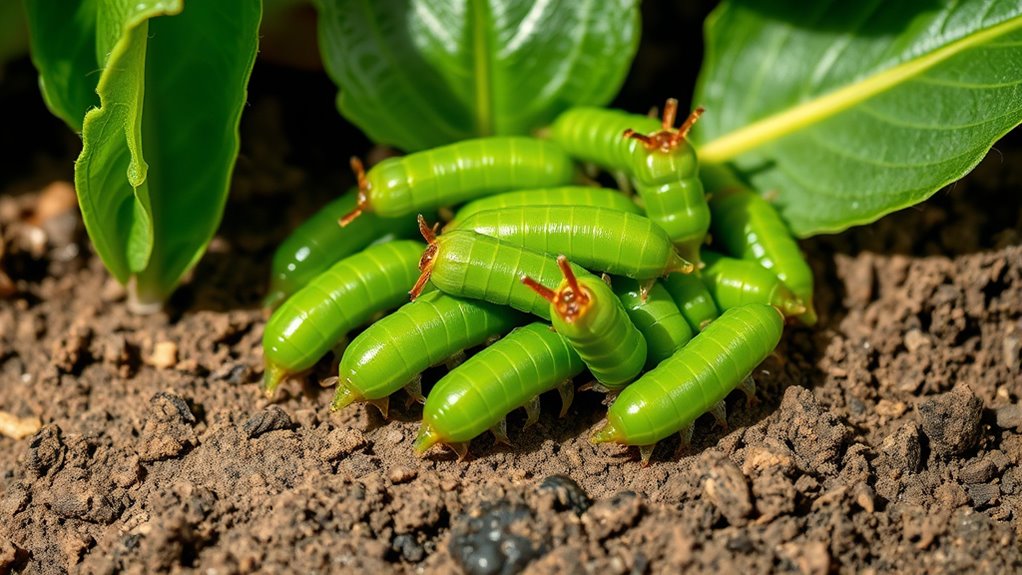If you’re exploring high-protein, sustainable food options, grasshopper grubs are a smart choice. They pack more protein per gram than beef and require fewer resources to farm. Their farming involves eco-friendly practices like using organic waste as feed and recycling water, making them a greener alternative. With their nutritional benefits and scalable production, grasshoppers could revolutionize your diet. Keep going to discover how these insects might just be your new food superstars.
Key Takeaways
- Grasshoppers are a highly nutritious, protein-rich insect that surpasses beef in protein efficiency and content.
- They require less feed, water, and land compared to traditional livestock, making them more sustainable.
- Insect farming techniques ensure hygiene, safety, and scalability for widespread consumption.
- Grasshopper protein has a lower environmental footprint, contributing to eco-friendly food systems.
- Incorporating grasshoppers into diets offers a sustainable, efficient alternative to conventional meat sources.

Have you ever considered that insects could be a sustainable and nutritious food source? As global food demands grow and environmental concerns rise, insects like grasshoppers are gaining attention for their potential to transform the way we think about nutrition and farming. Unlike traditional livestock, insect farming techniques have advanced rapidly, making insect cultivation more efficient, eco-friendly, and scalable. These methods involve sustainable farming practices that minimize land use, water consumption, and greenhouse gas emissions, positioning insects as a viable alternative to conventional animal protein.
You might wonder how insect farming works and why it’s such a promising approach. Insect farming techniques focus on creating controlled environments where insects are raised in large quantities with minimal resource input. These systems often utilize vertical farming setups or climate-controlled facilities to optimize growth rates and reduce environmental impact. Because insects like grasshoppers are cold-blooded, they convert feed to body mass more efficiently than traditional livestock, requiring less feed overall. This efficiency not only conserves resources but also helps reduce the carbon footprint associated with meat production.
The sustainability of insect farming is rooted in its ability to utilize organic waste streams. Insects can be fed on agricultural byproducts, food scraps, or other organic waste, turning waste into valuable protein. This closed-loop system lessens the burden on landfills and reduces the need for resource-intensive feed production. Additionally, insect farming requires substantially less water compared to cattle or pig farming, making it an attractive option in water-scarce regions. As you explore these techniques, you’ll see that insect farms can be set up in urban spaces or existing agricultural facilities, further reducing transportation costs and emissions.
Insect farming techniques emphasize hygiene and safety, ensuring that the insects are free from contaminants. Rearing environments are kept sterile, and harvesting methods are designed for efficiency and cleanliness. This approach guarantees that edible insects like grasshoppers are not only nutritious but also safe for human consumption. Furthermore, the scalability of these farming methods allows for large-scale production, making edible insects more accessible and affordable. Advances in projector technology and automation are also helping streamline insect farming practices, increasing efficiency and safety standards.
Incorporating insects into your diet could be more than just a trend; it’s a step toward more sustainable living. With ongoing innovations in insect farming techniques, the environmental benefits become even clearer. As you learn more about this sustainable farming approach, you’ll realize that insects like grasshoppers are not only rich in protein but also a vital part of a more sustainable food future.
Frequently Asked Questions
How Sustainable Is Grasshopper Farming Compared to Traditional Livestock?
You might wonder how sustainable grasshopper farming is compared to traditional livestock. It’s actually more eco-friendly, as it requires less land, water, and feed, leading to a smaller ecological impact. By choosing sustainable farming methods like insect farming, you help reduce greenhouse gas emissions and conserve resources. Grasshoppers grow quickly and efficiently, making them a smart, environmentally conscious alternative to conventional livestock, supporting a healthier planet.
Are Edible Insects Safe for People With Shellfish Allergies?
If you have shellfish allergies, you should be cautious with edible insects. Allergy considerations are important because there’s potential for cross reactivity between shellfish and certain insects like crickets or grasshoppers. While many people can eat insects safely, you should consult your allergist first. Always check labels and start with small quantities to monitor for any allergic reactions, ensuring your safety when trying edible insects.
What Are the Cultural Perceptions of Eating Grasshoppers Worldwide?
You might find that cultural perceptions of eating grasshoppers vary worldwide, shaping entomophagy acceptance differently across regions. In some cultures, like in parts of Africa, Asia, and Latin America, eating insects is traditional and celebrated through cultural insect dishes. However, in Western countries, it often faces skepticism due to unfamiliarity and social taboos. Understanding these diverse views helps you appreciate how insects are becoming more accepted globally.
How Is Insect Protein Processed for Human Consumption?
Processing insect protein is like turning raw diamonds into sparkling jewels. You start with insect extraction, where insects are collected and prepared. Then, you use insect drying methods—such as oven-drying or freeze-drying—to preserve them. Once dried, the insects are ground into powders or processed into bars, making insect protein easy to incorporate into your favorite foods. This efficient process guarantees a sustainable, high-protein addition to your diet.
What Are the Environmental Benefits of Choosing Grasshopper Grubs?
Choosing grasshopper grubs benefits the environment through sustainable insect farming, which has a lower environmental impact compared to traditional livestock. By opting for insect protein, you help reduce greenhouse gas emissions, conserve water, and minimize land use. Insect farming is efficient, requiring less feed and producing fewer waste products. This shift supports eco-friendly food choices, making a positive difference for the planet while providing a nutritious protein source.
Conclusion
Imagine biting into a crispy grasshopper or a tender grub, their flavors bursting like hidden treasures on your tongue. As you embrace these little protein powerhouses, you paint a vibrant picture of sustainable, nutritious eating that’s both adventurous and eco-friendly. So, next time you’re seeking a bold, delicious snack, consider these tiny warriors—crunchy, savory, and packed with more protein than beef. Plunge in, savor the surprise, and help shape a greener, tastier future.










